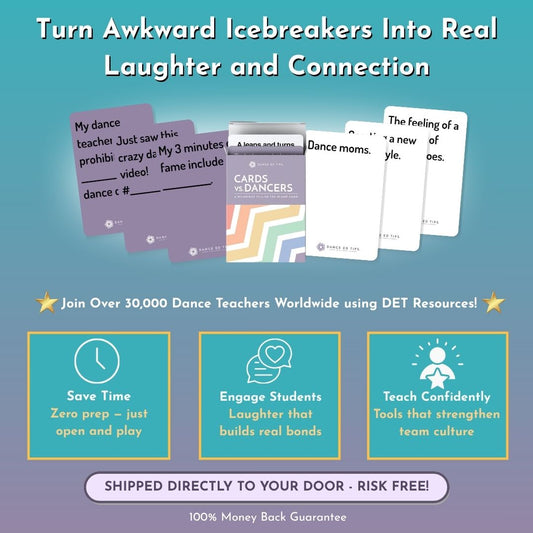By: Chelsea Pierotti
Whether you are auditioning, performing, or competing, dancers always want to be at their best when it counts. In an ideal world, each performance would be better than the last. The first competition would go well, you get good feedback, make improvements, and get even better the next time. But realistically, that’s not how it works.
What if your dancer’s performance is a disaster? Now what? How do you prepare your dancers to bounce back from that failure and improve the next time? Why are some athletes resilient in the face of failure and others lose hope?
Bottom line: Not everyone knows how to handle failure. It takes resilience training. And that starts with how you talk about a failure.
Whether it’s a mistake on stage, a fall in rehearsal, or a rejection letter, we all experience failure. And so much of a dancer’s reaction to a perceived failure comes from how you as a teacher react. It starts with how you teach them to treat their own failure. There are three key things to remember when you are talking to your dances about a failure:
- Failure is a part of the process
- Failure is something to be embraced
- Athletes don’t react to success and failures the same way
You want to encourage your dancers to perceive failure as a part of the learning process. It’s ok to feel a sense of disappointment at first, but that should pretty quickly turn to, “What did I learn from this?” “Where do we go now?” “How can I be better?” If your dancers learn to embrace failure, they are much more emotionally prepared for the next event and are more likely to improve their performance.
There are four steps to follow when you are helping an athlete deal with a mistake. As their teacher, you can help them learn to R.E.A.D. the circumstances correctly and build up a resilience to mistakes.
R = Recognize the error and the frustration it has caused
- Validate their feelings and emotions while guiding them to the mindset mantra “Control the Controllables” (for much more on that read this).The idea is that you train yourself to only worry about the things in your control and ignore the rest.
E = Evaluate the skill or routine and determine how and why the error occurred and determine how the dancer interprets the situation
- Don’t assume your dancer is making the same attribution for the mistake that you are. You might blame a poorly designed transition for a collision on stage, but they blame themselves for being terrible dancers. Talk about it and evaluate it together. Treat it as a learning process so the dancers can learn to be better at self-evaluation as they continue to grow and improve. Sometimes the cause of the mistake might be something in your dancers’ control like their focus, or future training. But if you believe the source of the mistake was outside of their control, make sure they are interpreting the cause of the failure in the same way as you.
A = Allow for time to practice
- Big changes in skill won’t happen overnight. Keep reminding the athlete that hard work matters, offer instruction and feedback, give praise when deserved, and guide him towards the end goal. Overall, praise effort over accomplishment. Dancers will build a growth mindset and be more resilient if they are praised for their hard work and effort along the way, and not just when they accomplish a goal.
D = Develop a plan (and communicate it to your dancer) to make the necessary corrections for the future
- When an athlete feels like there is a clear plan in place to make sure the mistake doesn’t happen again they are much more likely to maintain focus and effort during that time. Without it, a dancer may resort back to blaming herself for the failure and assume she isn’t good enough, so she ceases to put forth any more effort.

Bringing It All Together – Tips to Build a Resilient Athlete
- Failure isn’t just when you experience a big competitive failure. It could be a fall during an across the floor combination, or a poorly executed turn sequence in practice. Use those “small” low stakes failures to R.E.A.D. the situation and train for when mistakes happen on the big stage.
- Help your dancers explain failure as CONTROLLABLE and CHANGEABLE. Your language matters, so ensure failure is always perceived as in their control and changeable. If you believe it was uncontrollable (like the judges’ opinion) focus on what you can control (like attitude, effort, and performance quality) and emphasize the aspects of a failure that are changeable.
- Remember (and remind them) – Their mindset won’t change overnight. Some athletes have a habit of blaming themselves for every failure so keep at it and remind them they are in control of their success too!
- Talk to your athletes so you can recognize negative failure beliefs like, “I’m a terrible dancer.” Don’t assume they are making the right connections but have explicit conversations with your dancers and make the failure or mistake a valuable learning process.
- Challenge them - It’s tempting to compete against other dancers at competitions where you know you will be successful because it will boost confidence. But it actually has the opposite effect because the dancers know what’s going on. They attribute their success to the other dancers’ lack of ability and not their own talent. “We won because it was easy, not because we are talented.” Be wary of the dancer who attributes success to something outside of his or her control, that can be dangerous too! So, challenge your dancers in rehearsals and in competitions. Give them an opportunity to experience failures they learn to properly evaluate and experience successes they know they are responsible for!
For more ideas on how to help your dancers be resilient and develop a growth mindset, download the free cheat sheet:
37 Questions & Responses to Encourage a Growth Mindset in Your Dancers
https://passionatecoach.com/growthmindset

Chelsea Pierotti, Ph.D. is a Sport Psychology Consultant for dancers through her organization, Passionate Coach LLC. As a former professional ballet dancer and dance team coach she focuses on mental skills training including mental toughness, confidence, anxiety control, motivation, team building, and leadership. Much of her work is done in person through private workshops offered at studios, high schools, and colleges around the country. She is also a speaker on topics such as growth mindset, mental skills for competitive success, reducing performance anxiety, and more. Private phone coaching for individual dancers is also available. As dancers we train our bodies for hours on end, but sometimes it’s the mind that gets in the way of our success. As a Mental Performance Coach, Dr. Chelsea focuses on the mental side of dance, helping to ensure dancers can perform at their full potential when it counts.
Instagram: @passionatecoach
Facebook: https://facebook.com/passionatecoach
Website: https://passionatecoach.com
Email: chelsea@passionatecoach.com
Book a Discovery Call: https://passionatecoach.com/newclient





